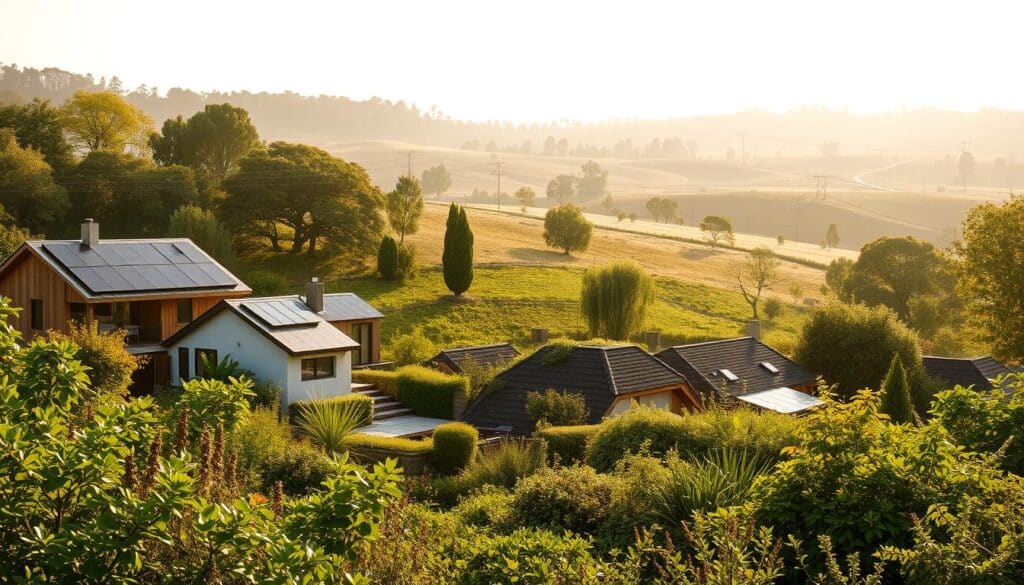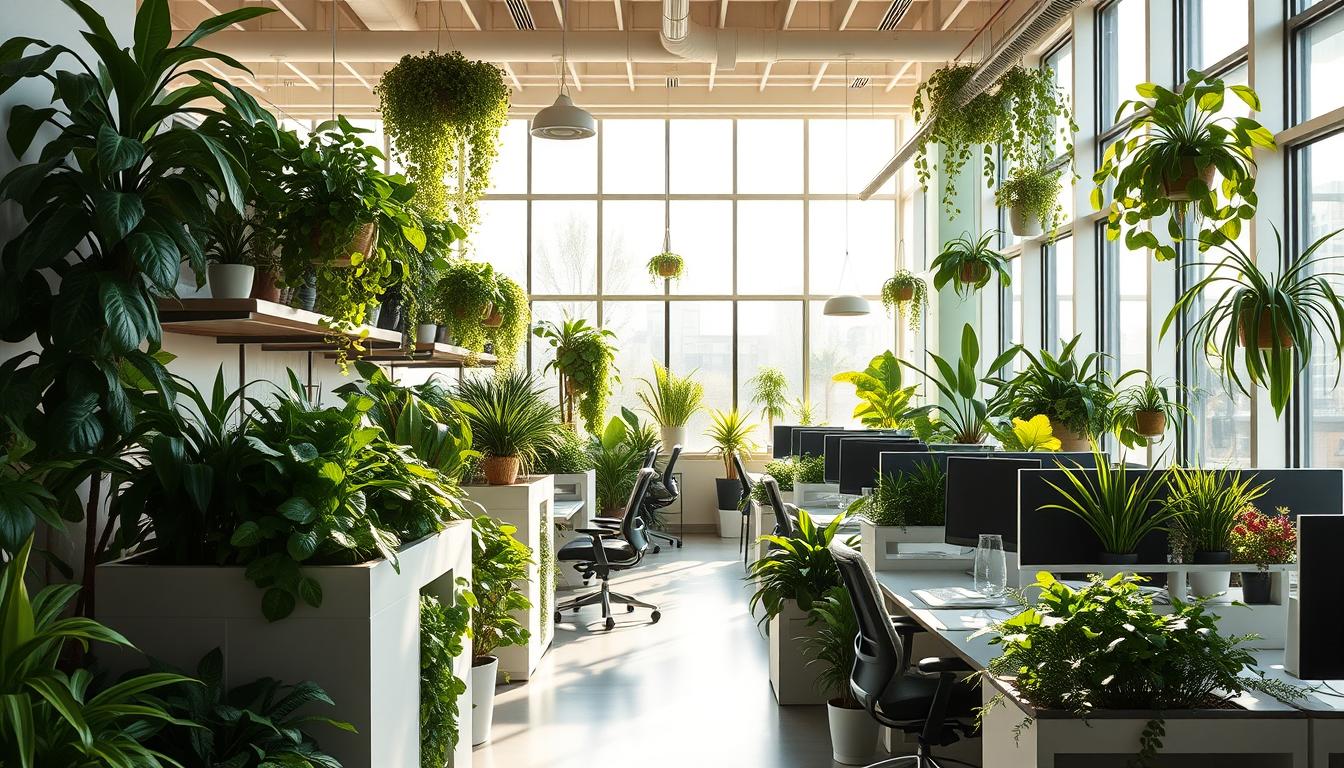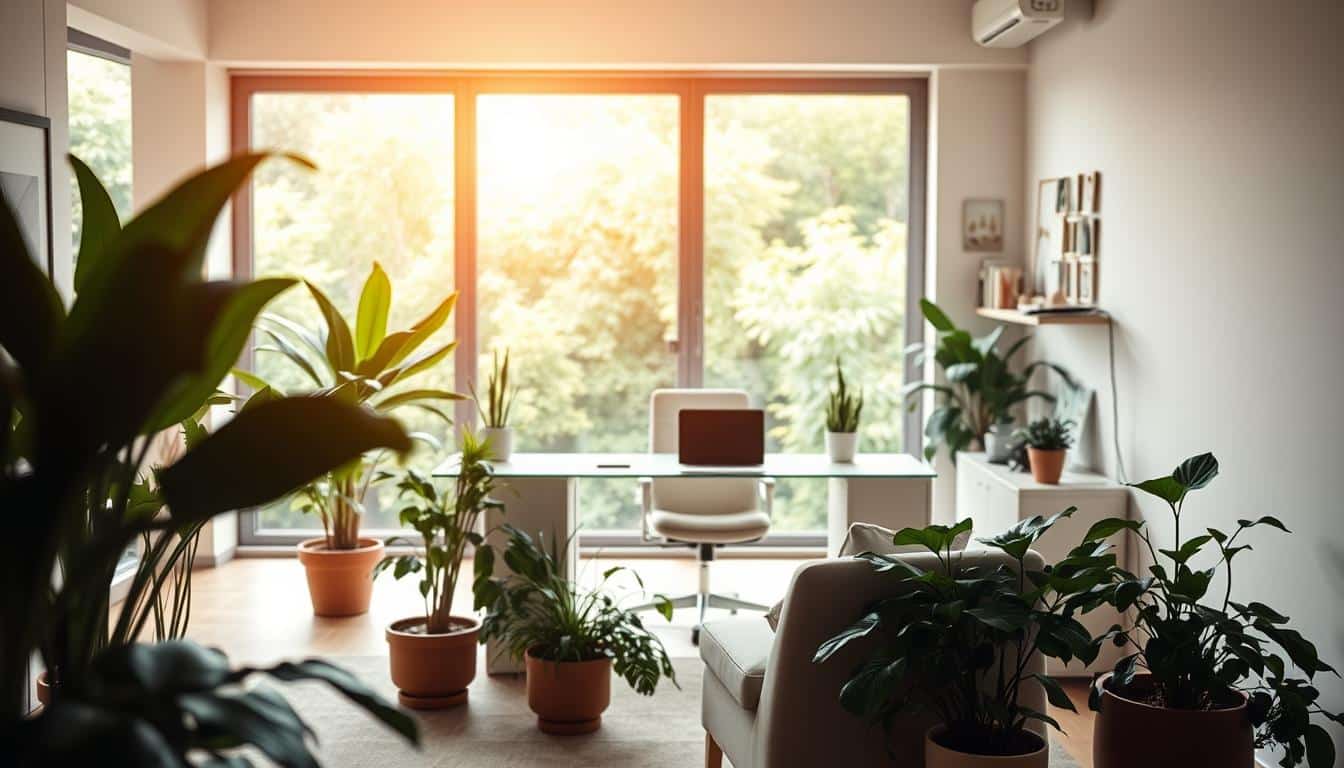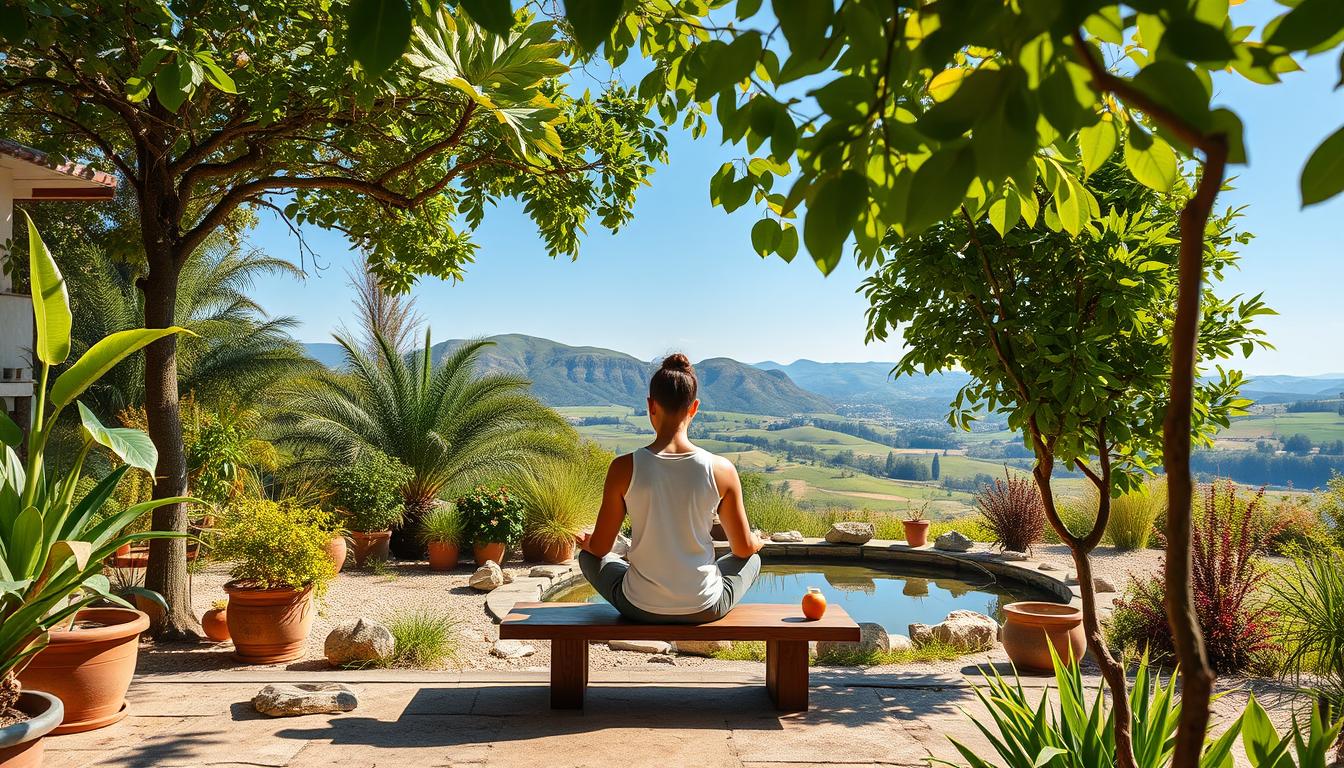Nowadays, thinking green when it comes to homes is more important than ever. People are starting to see how important it is to live in a way that’s good for our planet. They’re choosing to make their homes reflect their eco-friendly values. This means picking products and designs that do less harm to the environment.
Getting an eco-friendly home isn’t just about following a trend. It’s about making a real difference. This journey involves selecting materials that are kind to the earth, using smart designs, and reducing our energy use. Plus, working together as a community plays a big part in this movement. It’s about building a future that’s bright and healthy for everyone.
Understanding Eco-Friendly Homes
Eco-friendly homes are part of sustainable architecture. They focus on the health of our environment and saving resources. These homes use renewable energy, like solar power. They also have great insulation and energy-efficient appliances. Using sustainable materials in these homes reduces harm to our environment. It also makes living in them better.
These homes are designed to have clean air inside. They use safe materials and have good air flow. This makes the air healthier to breathe. Buildings like these help everyone by reducing harmful emissions. This means they lower the harmful gases we release into the air.
Eco-friendly homes can also save you money. They have lower energy bills thanks to their efficient design. There are even government rewards for using green energy. By choosing these homes, people show they care about our planet. This helps everyone work towards a better, more sustainable world.

The Importance of Sustainability in Modern Living
Today, saving our planet is more crucial than ever. Awareness about climate change is increasing. A whopping 85% of people see how climate change harms us. Because of this, many folks now prefer products that don’t hurt the environment. This shows their commitment to keeping the planet safe.
People are changing how they live to help the planet. They are now choosing things that are kind to the environment. Whether it’s buying energy-saving devices or organic foods, every choice matters. Each one helps lessen their impact on the earth.
Living sustainably does not just help the earth. It also makes our own lives better. It encourages us to buy wisely and live in a way that feels right. In the end, being sustainable shows we care about the planet’s future. It shows we’re thinking about the next generations.
Creating a Sustainable Identity Through Interior Ecology
A sustainable identity is more than making a space look good. It’s about choosing to live eco-friendly, matching our actions to what we believe. We call this interior ecology. It’s about designing our homes to show our commitment to the planet. By doing so, our homes become a reflection of our choice to back green brands and products.
Defining Sustainable Identity
What is a sustainable identity? It’s where personal beliefs and caring for the earth meet. Making a home that reflects this needs careful thought. We must consider everything from the materials we use to how rooms are laid out. Choose renewable resources, and our homes will show our commitment to protecting the environment. Every choice, from paint colors to furniture placement, not only helps the planet but also makes our space truly ours.
How Interior Ecology Influences Lifestyle Choices
Interior ecology and our daily choices are closely linked. Designing with green materials and smart layouts encourages us to live sustainably. For example, a well-planned space might lead to using less energy. Letting more natural light in can make us feel better and cut down on electricity use. By considering our interiors, we can shape our homes to inspire a greener way of life.
Eco-Friendly Materials for Your Home
Using eco-friendly materials in your home looks great and helps the planet. Many options are biodegradable, which means they break down naturally. They keep your home functional and beautiful while caring for the environment.
Biodegradable Options and Their Benefits
Going for biodegradable stuff cuts down waste and supports a green lifestyle. Here are some top picks:
- Bamboo: It grows fast and is perfect for floors, furniture, and decorations.
- Reclaimed Wood: This wood stops trees from being cut down and adds charm to any space.
- Natural Fabrics: Picks like organic cotton, wool, and linen are earth-friendly. Plus, they feel good and look cool.
By choosing these materials, you make sure what’s in your home will return to earth safely. They help us stick to a sustainable path without causing harm.
Third-Party Certifications and Their Credibility
When buying green materials, look for labels that prove they are truly eco-friendly. Trusted names to look for include:
- Energy Star: They point out products that use less energy and can lower your bills.
- Forest Stewardship Council (FSC): This shows wood comes from forests that are looked after well.
- Cradle to Cradle: They focus on making products in a way that’s good for the earth from start to finish.
Knowing about these labels matters. It helps you choose wisely and avoid fake green claims. Clear, honest eco-labels build trust. They lead to real green living.
Designing an Eco-Conscious Space
When you create an eco-conscious space, you focus on sustainability and making a house more comfortable and beautiful. You choose natural materials, energy-efficient machines, and water-saving fixtures. These choices make your home look good and help our planet.
Elements of Eco-Friendly Design
The key parts of eco-friendly design are:
- Natural stuff like bamboo and reused wood, which are good for our Earth.
- Machines that use less power.
- Fixtures that save water.
- Materials that reduce trash, like recycled glass and safe paints.
These parts don’t just help the Earth. They also fit with the idea of making homes that work well and are good for our environment.
Color Palette Selection and Its Impact on Mood
Choosing colors is important in eco-friendly design. Colors that remind us of the Earth can make us feel calm. Think about using greens, beiges, and light browns. These colors can make us feel connected to nature.
By adding simple designs in these colors, you make the place look nicer. At the same time, it becomes a peaceful spot that makes people feel good.
Energy-Efficient Solutions for Your Home
Making your home energy-efficient cuts down energy use and cost. Today, smart home tech lets homeowners easily save energy. These new tech options are both useful and perfect for living green.
Smart Home Technology for Energy Conservation
Smart home tech is changing how we use energy at home. Here’s a look at some key options:
- Smart Thermostats: Devices like the Nest or Ecobee adjust the temperature for you. They learn your routine to save energy and keep you comfy.
- Energy-Efficient Lighting: LED bulbs lower electricity use. They also work with smart systems for better control.
- Solar Panel Installations: Solar panels use the sun for power. This lessens our need for other energy sources.
Using smart tech for saving energy brings big savings over time. You get better control of how much energy you use. This helps your wallet and the earth too.
The Role of Natural Light in Sustainable Living
Natural light is key in sustainable living, making indoor spaces better. It lessens the need for electric lights and helps save energy. Including natural light in home design creates warm, inviting spaces that improve our well-being.
Big windows and open layouts let the sunlight spread through a house. Skylights also bring in light without losing privacy. These methods connect our indoor spaces with the outside world, making life more in tune with nature.
Natural light boosts our mood and helps us work better by upping serotonin. People living in sun-filled spaces often sleep well and feel healthier. This shows how vital it is to bring natural light into our homes.
Using natural light is not just about making spaces look good. It’s about living sustainably. Smart design that focuses on sunlight results in healthier homes and lively indoor places.
Building a Community Around Eco-Friendly Values
Starting a community with eco-friendly values helps sustainable practices grow. Involving community members encourages everyone to take care of the environment. By holding events on sustainability, workshops, and environmental initiatives, we can both teach and motivate people to act.
How Community Engagement Enhances Sustainable Practices
Community involvement is key to eco-friendly projects’ success. When people unite, they form a supportive network for green choices. They can exchange knowledge, ideas, and resources which boost the effect of their efforts. Working together on neighborhood clean-ups or communal gardening shows how teamwork makes a difference in supporting eco-friendly principles.
Local Resources for Eco-Friendly Living
Access to local resources makes living sustainably easier. Communities often have guides to sustainability, farmers’ markets, and programs that support local agriculture. This helps residents find and choose eco-friendly options. It enables people to make choices that benefit the planet’s future.
Challenges of Crafting a Sustainable Identity
For brands, creating a sustainable identity comes with many hurdles, especially in eco-branding. The concept of greenwashing describes when companies overstate their green efforts, causing distrust. To be seen as credible, a brand must be open and stick to real green practices. Greenwashing can greatly harm consumer trust and the realness of a brand.
Avoiding Greenwashing in Eco-Branding
Brands need to adopt real green actions rather than make false claims. More and more consumers recognize sustainability issues and can spot greenwashing. By being honest about their green actions, brands can steer clear of the troubles linked with misleading marketing.
Consumer Trust and Brand Authenticity
Winning consumer trust depends on matching what a brand says with what it does. The story of 3M shows why being authentic matters. They faced legal issues over false environmental claims. This proves that to win in today’s market, brands must act as they say. Being open helps brands face sustainability challenges and strengthens their bond with aware consumers.
Innovative Ideas for Sustainable Homes
Eco-friendly living is becoming more popular, pushing the need for innovative home design. By upcycling and reusing materials, we not only make our homes unique but also cut down on waste. This approach is key to living sustainably, bringing a personal touch to our spaces while caring for the earth.
Upcycling and Repurposing in Design
Upcycling has become a big trend in eco-friendly home design. It’s about turning old materials into something new and useful. Here are some cool ideas:
- Furniture made from reclaimed wood adds both durability and charm.
- Old doors and windows find new life as decorative or useful pieces.
- Using glass jars for storage brings a vintage vibe.
- Transforming textiles from worn-out clothes into art or pillows.
These examples show how upcycling encourages creativity and helps our planet.
Integrating Nature into Home Interiors
Bringing nature into our homes is essential for modern, eco-friendly designs. Biophilic design makes inside spaces better for our health and happiness. Here are some ways to do it:
- Large windows flood rooms with natural light.
- Indoor plants clean the air and add beauty.
- Materials like stone and bamboo create a natural feel.
- Design outdoor areas to feel like part of the indoors.
Adding nature to our homes makes them more beautiful and peaceful. It also helps us feel connected to the world around us.
Conclusion
Living a green life is about more than following trends. It’s a key answer to our environmental issues. Moving towards a greener home means making smart choices, like using sustainable materials and saving energy. Together, these small actions lead to big changes.
It’s important to think about how we can live more sustainably. Choosing clean energy, using tech wisely, or joining local green projects can make a big difference. Living this way helps us and the Earth for years to come.
Looking ahead, let’s keep up our green efforts. Staying up to date on eco-friendly ways and finding new solutions keep our homes and lifestyles in line with our eco goals. By working together, we can make our world a better place.



